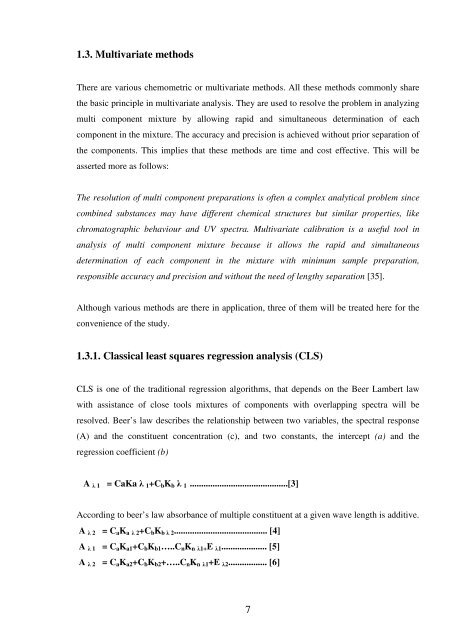CHEMOMETRICS ASSISTED UV-SPECTROPHOTOMETRIC ...
CHEMOMETRICS ASSISTED UV-SPECTROPHOTOMETRIC ...
CHEMOMETRICS ASSISTED UV-SPECTROPHOTOMETRIC ...
You also want an ePaper? Increase the reach of your titles
YUMPU automatically turns print PDFs into web optimized ePapers that Google loves.
1.3. Multivariate methods<br />
There are various chemometric or multivariate methods. All these methods commonly share<br />
the basic principle in multivariate analysis. They are used to resolve the problem in analyzing<br />
multi component mixture by allowing rapid and simultaneous determination of each<br />
component in the mixture. The accuracy and precision is achieved without prior separation of<br />
the components. This implies that these methods are time and cost effective. This will be<br />
asserted more as follows:<br />
The resolution of multi component preparations is often a complex analytical problem since<br />
combined substances may have different chemical structures but similar properties, like<br />
chromatographic behaviour and <strong>UV</strong> spectra. Multivariate calibration is a useful tool in<br />
analysis of multi component mixture because it allows the rapid and simultaneous<br />
determination of each component in the mixture with minimum sample preparation,<br />
responsible accuracy and precision and without the need of lengthy separation [35].<br />
Although various methods are there in application, three of them will be treated here for the<br />
convenience of the study.<br />
1.3.1. Classical least squares regression analysis (CLS)<br />
CLS is one of the traditional regression algorithms, that depends on the Beer Lambert law<br />
with assistance of close tools mixtures of components with overlapping spectra will be<br />
resolved. Beer’s law describes the relationship between two variables, the spectral response<br />
(A) and the constituent concentration (c), and two constants, the intercept (a) and the<br />
regression coefficient (b)<br />
A λ 1 = CaKa λ 1+CbKb λ 1 ...........................................[3]<br />
According to beer’s law absorbance of multiple constituent at a given wave length is additive.<br />
A λ 2 = CaKa λ 2+CbKb λ 2......................................... [4]<br />
A λ 1 = CaKa1+CbKb1…..CnKn λ1+E λ1.................... [5]<br />
A λ 2 = CaKa2+CbKb2+…..CnKn λ1+E λ2................. [6]<br />
7

















